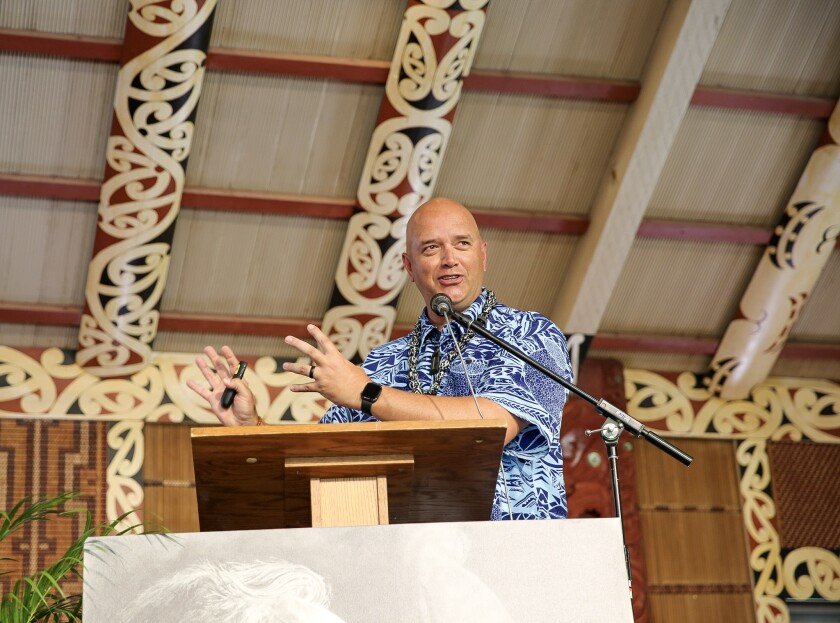
As Proclaim Peace conference attendees walked into the Aotearoa Village at the Polynesian Cultural Center on the last day of the three-day event, they witnessed a rare Maori ceremony that BYU–Hawaii alumnus Seamus Fitzgerald said he had only seen twice in this lifetime. After the attendees were seated, Fitzgerald and Aotearoa Village Manager Kim Makekau did a call and response oration in Maori. Conference attendees said there was a tangible spirit in the air that they felt.
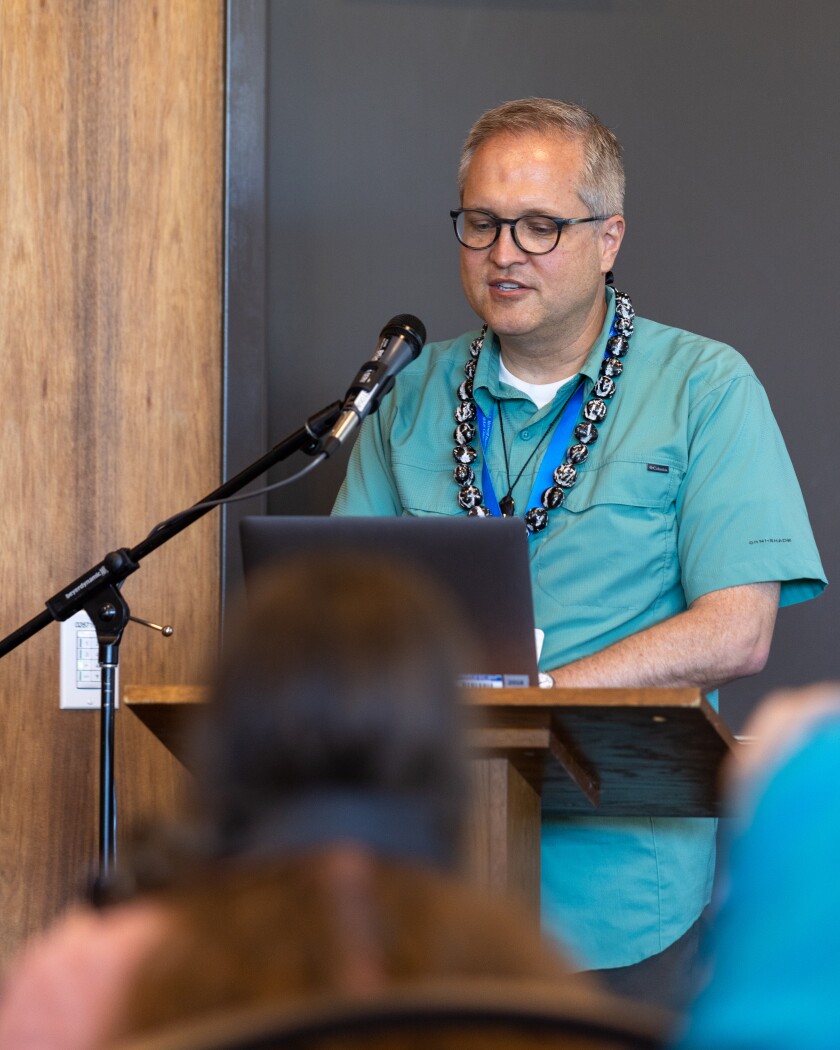
Author David Pulsipher, an American Studies professor at BYU-Idaho, said of the experience, “I know the ancestors are here, and I know that we cannot build peace without them.”
Fulfilling the prophecy of peace
BYUH Associate Professor Chad Ford in the Faculty of Culture, Language & Performing Arts and head of the Intercultural Peacebuilding Program, said, “This is the second time I’ve felt the presence of David O. McKay here in this Marae [an open-ground, sacred space in Maori culture].” BYUH’s McKay Center was created to fulfill President David O. McKay’s prophecy that from this school men and women would go forth to establish peace internationally.
BYUH alumni shared how they are fulfilling the prophecy by building peace around the world, in Nigeria, Hong Kong, Fiji, and Oregon. To read about the alumni’s work, click here.

Fighting for peace
Ford gave the final remarks, saying that Jesus’s ministry was audacious, or fearless. So audacious that the people of his home town, Nazareth, attempt to throw Jesus off a cliff. Jesus’ talk of peace, hope, justice, forgiveness and reconciliation did not sit well with the oppressed Israelites, said Ford. They wanted a Messiah who would fight -- not love.
Ford said Jesus’ message is just as audacious today as it was back then. Reflecting on the horrors ravaging the world today, Ford said, “At times I feel it’s not enough for God to weep. I want him to fight, or in the very least, I want to fight on his behalf. If we are to renounce war and proclaim peace like Jesus, it will be inconvenient at best, and for some, it may cost us our lives.”
Ford recognized those who have or are audaciously walking the path of peace, using a tradition he learned in the Middle East. “When you acknowledge ancestors or the living who have dug the wells from which we drink, we acknowledge them with a single, reverent clap,” he explained.
He invited the crowd to clap for the peacebuilders he named.
Blessed be Enoch clap
Blessed be Esau clap
Blessed be Abigail clap
Blessed be the Anti-Nephi-Lehies clap
Blessed be the Moriori clap
Blessed be Joseph Smith clap
Blessed be Emma Smith clap
Blessed be President Russell M. Nelson clap
Blessed be the Kanaka Maoli [Native Hawaiians] clap
The list of peacebuilders continued as the spirit in the room intensified, said audience members. The conference then ended with a standing ovation.

Proclaiming peace today
During the last session in the Marae, Author Patrick Mason, a historian who holds the Leonard J. Arrington Chair of Mormon History and Culture at Utah State University, also focused on the Savior. With tears in his eyes, he talked about the people of Ukraine, Afghanistan, Yemen, Myanmar, Ethiopia, and the other 38-armed conflicts raging around the world including the victims and families of mass shootings across the United States. “This is why Jesus came into the world,” he said, “and why he called us to be peacemakers: to help heal a fallen, broken, violent world.”
Mason said The Book of Mormon teaches people that violence begets violence, and counsels them to do better. He believes that “proclaiming peace is part of the covenant path for all Christians. We love God because God loved us first. We proclaim peace because Jesus proclaimed peace first.”
Mason and Pulsipher have co-written a book, “Proclaim Peace: The Restoration’s Answer to an Age of Conflict” that the conference centered around. To read about how their book came to be, click here.
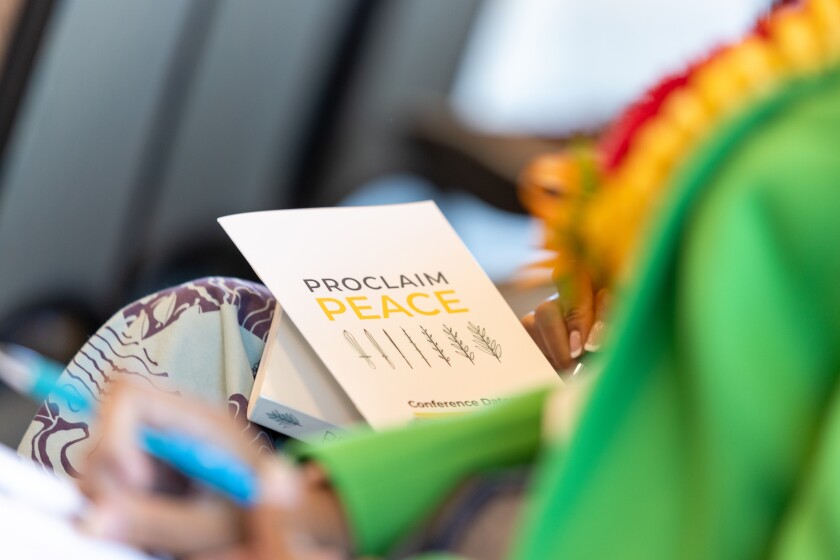
A personal perspective on peace
One of the speakers at the conference, Melissa Inouye, a historian at the Church History Library and a lecturer at the University of Auckland, addressed the crowd after completing chemo therapy just a week prior.
Inouye, began her presentation with a personal story that deepened her perspective. She said she attended a meeting run by a conservative group that wanted to hold teachers accountable for what they teach in the classroom.
“I sat and listened,” Inouye said, but “by the end, I was annoyed and discouraged. They saw insidious plots behind words like ‘diversity,’ ‘college readiness’ and even ‘compassion.’ Were they saying we should instead value ‘homogeneity,’ ‘college unreadiness’ and ‘malice’?” Inouye rhetorically asked.
Inouye said by the end of the meeting, one of the speakers of the group stopped to talk to her. As a fellow Latter-day Saint, Inouye asked the speaker what she thought of President Russell M. Nelson’s divine call to abandon attitudes and actions of prejudice. The speaker told her that was exactly what she was doing.
“I stood there, completely gobsmacked,” Inouye said. “We had taken the same prophetic charge and run with it in completely opposite directions.” Not only was Inouye baffled, she said, but also she was deeply troubled.
“What happens when the people you are in conflict with are your covenant brothers and sisters?” she asked. She said she wanted to know, “How can we all be on the same path when we often are headed in different directions - tripping and blocking each other on the path?”
Inouye shared with the conference attendees that in that moment of conversation she started to cry. She said the woman who was her political enemy hugged her.
“I felt in that conversation with a person I’ve long vilified that she was sincerely trying to do the right thing,” said Inouye. Inouye expressed gratitude for members in her ward who ideologically she did not agree with, nor they her, but who still chose to take care of her during her cancer treatment.
She concluded that covenant relationships don’t make people all the same, but rather give them the security to explore those differences, transcend them, and to “see as God sees.”
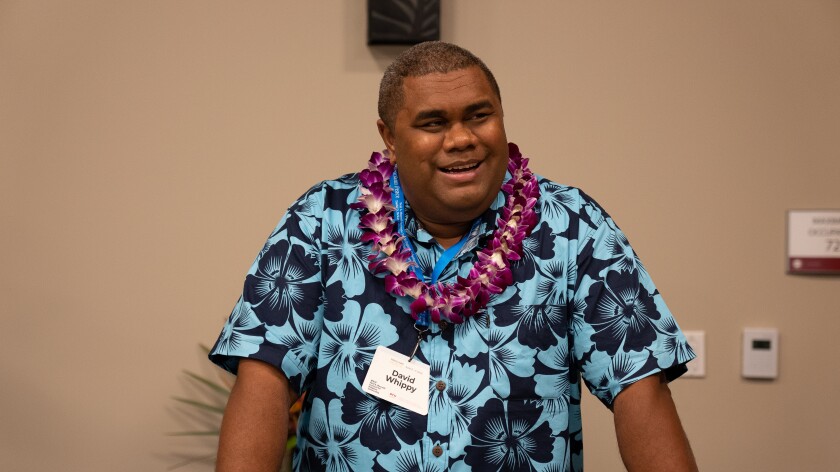
Historical and scriptural ties
While Inouye shared a personal story, David Whippy, assistant professor in the Faculty of Culture, Language & Performing Arts, shared a historical example of portraying peace in action.
Whippy shared about the Moriori of Rekohu, or the native Polynesian people of the New Zealand Chatham Islands, who practiced nonviolence. He said the pre-Christian Moriori buried and burned their weapons of war. They entered into a covenant with their gods, said Whippy, giving the gods the power of life and death.
Tohinga is a peace ceremony of the Moriori, he said, where children are given weapons, told the weapons are used to kill people, and then the child places the weapon back on the Tuahu, or sacred altar, symbolizing the renewal of the covenant for the next generation. Whippy likened the Moriori with the Anti-Nephi-Lehi’s in The Book of Mormon.
The story of the Anti-Nephi-Lehi’s sits exactly at the center of The Book of Mormon in Alma, added Mason. He cited Chris Thomas, the scholar who said the centrality of the story is not an accident but a narrative decision that should carry deep meaning for readers.
Jonah Gunter, a junior from Kaaawa studying intercultural peacebuilding, said during the questions and answer session, “The Anti-Nephi-Lehi’s story seems to stand in stark contrast to Captain Moroni and war narratives in the Book of Mormon. I feel like the just war is much more emphasized than the nonviolence in our Latter-day Saint culture.”
In response to Gunter’s remark, Mason said, “I joined the Church of Jesus Christ not the church of Captain Moroni. I don’t worship Moroni. I respect him. I don’t worship Mormon or Teancum. I don’t worship Joseph Smith. I worship Jesus Christ with his holy and entirely non-violent life, ministry, atonement, death, and resurrection.”
Samoan ritual of peace
In that same session, Christina Akanoa, an assistant professor in the BYUH Faculty of Business & Government, shared an example of a culture of peace from her home in Samoa.
Her brother accidentally hit a woman while driving, Akanoa said. He immediately took her to the hospital, but she died. Akanoa said in Samoa, an eye-for-an-eye concept can be applied. So her family prepared for an ifoga.
Ifoga is a reconciliation ritual, said Akanoa, where the family of the offender presents money, food, and expensive mats to the family of the offendee. The offending family takes the gifts to the village of the victim, bows down and covers themselves in mats. Akanoa said they will stay bowed down and covered until the family of the victim uncovers them, signifying their forgiveness.

The power of a diplomacy
After Akanoa spoke, Ben Cook, the director for the Center of Conflict Resolution at BYU in Provo, addressed the crowd. He emphasized the importance of “track 2 diplomacy,” or a grassroots form of diplomacy, as opposed to the structural forms.
He asked the crowd, “How do you stop a stampeding herd of cattle? I don’t know, but I know how to start a stampede.” Cook explained it is much easier to start conflict, but people seem to be at a loss on how to stop it. “It feels to me like we’re this herd of cattle that is all charging into an abyss, and we’re all blaming each other and nobody is taking accountability. It feels urgent to me that something be done,” he said.
Cook told the crowd about an Israeli woman who was afraid anytime she heard someone speak Arabic. When she had the chance to interact with and got to know some Palestinians, she learned their language. Cook said once this woman knew Arabic, she found out her neighbor yelling was calling to her children, telling them not to kill the Jews.
Cook said track 2 diplomacy has the power to take away fear as people get to know their enemies as people. He referenced the book “Why the Church is as True as the Gospel” by Eugene England, to bring his point home explaining Church wards have a vital role in peacebuilding. Cook said wards are set up so ward members have to love and serve people they normally would never choose to associate with or help.
Theology of peace
Speaking during the Theology of Peace session, Adam Miller, a philosophy professor at Collin College, began his presentation with the question “Do resurrected bodies need to eat?”
Miller continued, “Jesus showed that resurrected bodies can eat, but do they need to? I assume that most would automatically answer, ‘No.’ This would be silly and defeat the point of having a perfected body. This posits that a perfect version of life is not dependent on other lives for its own. We’ve posited a version of divine life that is no longer interdependent.”
In response to Miller’s question regarding his book, Mason said, “I’d say, ‘Yeah we eat in heaven,’ because I really like to eat.”
To explain his theory further, Miller used the analogy of musical chairs. He asked whether peace means a world where everyone eventually gets their own chair, and therefore no more movement, interaction or relationship. Or, if peace means there will always be a scarcity of chairs, meaning people will always be in motion, sharing the chairs between everyone.
Miller said he believes there will always be a metaphorical shortage of chairs, but that peace means people learn how to relate to that shortage through sacrifice and consecration, by serving and being served by others.
“Peace for reals and for keeps means a world that is eternally interdependent which means handling the divine shortage of chairs,” Miller concluded.
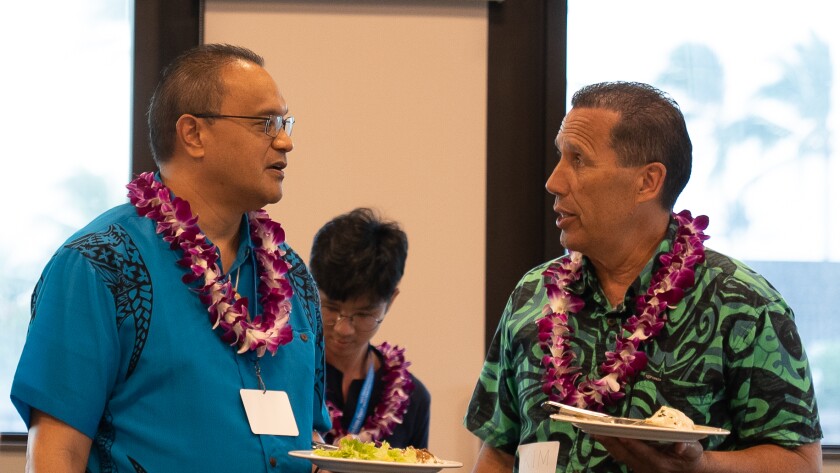
Polynesian perspective of peace
The last speaker in the culture of peace session was Tevita Kaili, dean of the BYUH Faculty of Culture, Language & Performing Arts. Kaili talked about his perspective on peacebuilding as a Tongan.
His quote, “When you live on an island, there’s no other place to go. You have to figure out how to get along,” was repeatedly referenced throughout the conference.
Kaili shared the Tongan Ta-Va, or time-space, theory. He said in everything there is hoa, or duality, and that there needs to be some sort of constant mediation and reconciliation between the hoa to produce symmetry, harmony, and beauty. An example Kaili gave was the duality between land and ocean in pacific cosmology.
